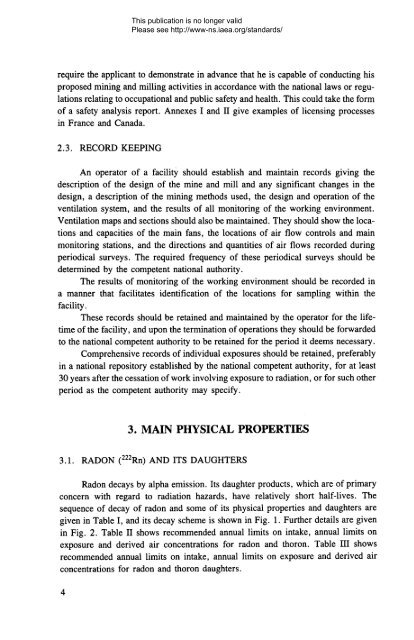IAEA SAFETY GUIDES - gnssn - International Atomic Energy Agency
IAEA SAFETY GUIDES - gnssn - International Atomic Energy Agency
IAEA SAFETY GUIDES - gnssn - International Atomic Energy Agency
You also want an ePaper? Increase the reach of your titles
YUMPU automatically turns print PDFs into web optimized ePapers that Google loves.
This publication is no longer validPlease see http://www-ns.iaea.org/standards/require the applicant to demonstrate in advance that he is capable of conducting hisproposed mining and milling activities in accordance with the national laws or regulationsrelating to occupational and public safety and health. This could take the formof a safety analysis report. Annexes I and II give examples of licensing processesin France and Canada.2.3. RECORDKEEPINGAn operator of a facility should establish and maintain records giving thedescription of the design of the mine and mill and any significant changes in thedesign, a description of the mining methods used, the design and operation of theventilation system, and the results of all monitoring of the working environment.Ventilation maps and sections should also be maintained. They should show the locationsand capacities of the main fans, the locations of air flow controls and mainmonitoring stations, and the directions and quantities of air flows recorded duringperiodical surveys. The required frequency of these periodical surveys should bedetermined by the competent national authority.The results of monitoring of the working environment should be recorded ina manner that facilitates identification of the locations for sampling within thefacility.These records should be retained and maintained by the operator for the lifetimeof the facility, and upon the termination of operations they should be forwardedto the national competent authority to be retained for the period it deems necessary.Comprehensive records of individual exposures should be retained, preferablyin a national repository established by the national competent authority, for at least30 years after the cessation of work involving exposure to radiation, or for such otherperiod as the competent authority may specify.3. MAIN PHYSICAL PROPERTIES3.1. RADON (222Rn) AND ITS DAUGHTERSRadon decays by alpha emission. Its daughter products, which are of primaryconcern with regard to radiation hazards, have relatively short half-lives. Thesequence of decay of radon and some of its physical properties and daughters aregiven in Table I, and its decay scheme is shown in Fig. 1. Further details are givenin Fig. 2. Table II shows recommended annual limits on intake, annual limits onexposure and derived air concentrations for radon and thoron. Table III showsrecommended annual limits on intake, annual limits on exposure and derived airconcentrations for radon and thoron daughters.4
















